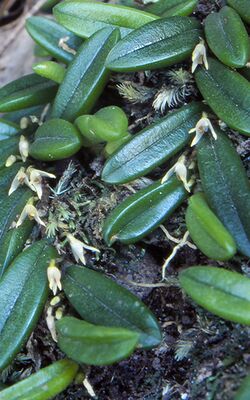Biology:Bulbophyllum shepherdii
| Wheat-leaf rope orchid | |
|---|---|

| |
| Bulbophyllum shepherdii in the Bomaderry Creek Reserve | |
| Scientific classification | |
| Kingdom: | Plantae |
| Clade: | Tracheophytes |
| Clade: | Angiosperms |
| Clade: | Monocots |
| Order: | Asparagales |
| Family: | Orchidaceae |
| Subfamily: | Epidendroideae |
| Genus: | Bulbophyllum |
| Species: | B. shepherdii
|
| Binomial name | |
| Bulbophyllum shepherdii (F.Muell.) Rchb.f.[1]
| |
| Synonyms[1] | |
| |
Bulbophyllum shepherdii, commonly known as the wheat-leaf rope orchid,[2] is a species of epiphytic or lithophytic orchid that forms a dense mat of branching rhizomes pressed against the surface on which it grows. The pseudobulbs are well spaced along the rhizome, each with a single egg-shaped leaf and a single small, white or cream-coloured flower with yellow tips. It grows on trees and rocks in rainforest and is endemic to eastern Australia .
Description
Bulbophyllum shepherdii is an epiphytic or lithophytic herb with branching rhizomes forming a dense mat on the substrate. The pseudobulbs are more or less spherical but flattened 2–3 mm (0.08–0.1 in) in diameter separated by 2–9 mm (0.08–0.4 in). Each pseudobulb has a grooved, stalkless, elliptic to egg-shaped leaf 20–40 mm (0.8–2 in) long and 6–8 mm (0.24–0.31 in) wide with a channelled upper surface. A single white or cream-coloured flower with yellow tips, 4–5 mm (0.16–0.20 in) long and 2–3 mm (0.079–0.12 in) wide is borne on a flowering stem 5–9 mm (0.2–0.4 in) long. The flowers do not open widely. The sepals and petals are fleshy, the sepals 4–5 mm (0.16–0.20 in) long, about 2 mm (0.08 in) wide and the petals about 2 mm (0.08 in) long and 1.5 mm (0.06 in) wide. The labellum is reddish brown, about 2 mm (0.08 in) long and 1 mm (0.04 in) wide with smooth edges and a sharp bend near the middle. Flowering occurs from March to August.[2][3]
Taxonomy and naming
The wheat-leaf rope orchid was first formally described in 1859 by Ferdinand von Mueller who published the description in Fragmenta phytographiae Australiae from a specimen collected by T.W. Shepherd.[4][5] In 1870 Heinrich Gustav Reichenbach changed the name to Bulbophyllum shepherdii.[6] The specific epithet (shepherdii) honours Thomas William Shepherd who collected the type specimen.[7]
Distribution and habitat
Bulbophyllum shepherdii grows on trees and rocks in rainforest and wet forest between Nambour in Queensland and Bega in New South Wales.[2][3]
References
- ↑ Jump up to: 1.0 1.1 "Bulbophyllum shepherdii". World Checklist of Selected Plant Families (WCSP). Royal Botanic Gardens, Kew. http://wcsp.science.kew.org/namedetail.do?name_id=27367.
- ↑ Jump up to: 2.0 2.1 2.2 Jones, David L. (2006). A complete guide to native orchids of Australia including the island territories. Frenchs Forest, N.S.W.: New Holland. pp. 429–430. ISBN 1877069124.
- ↑ Jump up to: 3.0 3.1 "Bulbophyllum shepherdii". Royal Botanic Garden Sydney. http://plantnet.rbgsyd.nsw.gov.au/cgi-bin/NSWfl.pl?page=nswfl&lvl=sp&name=Bulbophyllum~shepherdii.
- ↑ "Dendrobium shepherdii". APNI. https://id.biodiversity.org.au/instance/apni/505783.
- ↑ von Mueller, Ferdinand (1859). Fragmenta phytographiae Australiae (Volume 1). Melbourne: Victorian Government Printer. pp. 190–191. https://www.biodiversitylibrary.org/item/202689#page/214/mode/1up. Retrieved 10 December 2018.
- ↑ "Bulbophyllum shepherdii". APNI. https://id.biodiversity.org.au/instance/apni/479759.
- ↑ "Shepherd, Thomas William (1824 - 1884)". Australian National Botanic Garden. http://www.anbg.gov.au/biography/shepherd-thomas-william.html.
Wikidata ☰ Q4995738 entry

